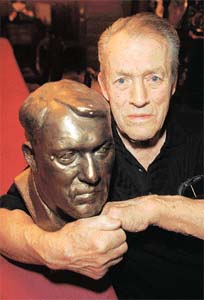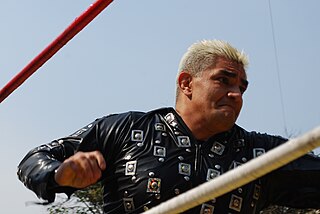 W
WBarbed Wire, Hoodies & Chokeslams was a professional wrestling live event produced by Extreme Championship Wrestling (ECW) on June 17, 1995. The event was held in the ECW Arena in Philadelphia, Pennsylvania in the United States.
 W
WBattle 7 was a professional wrestling event produced by New Japan Pro-Wrestling (NJPW) that took place on January 4, 1995 in the Tokyo Dome. Battle 7 was the fourth January 4 Tokyo Dome Show held by NJPW. The show drew 52,500 spectators and $4,800,000 in ticket sales.
 W
WThe CMLL 62nd Anniversary Show was a professional wrestling major show event produced by Consejo Mundial de Lucha Libre (CMLL) that took place on September 22, 1995 in Arena México, Mexico City, Mexico. The event commemorated the 62nd anniversary of CMLL, the oldest professional wrestling promotion in the world. The Anniversary show is CMLL's biggest show of the year, their Super Bowl event. The CMLL Anniversary Show series is the longest-running annual professional wrestling show, starting in 1934.
 W
WThe CMLL International Gran Prix (1995) was a lucha libre, or professional wrestling, tournament produced and scripted by the Mexican professional wrestling promotion Consejo Mundial de Lucha Libre which took place on July 7, 1995 in Arena México, Mexico City, Mexico, CMLL's main venue. The 1995 International Gran Prix was the second time CMLL has held an International Gran Prix tournament since 1994. All International Gran Prix tournaments have been a one-night tournament, always as part of CMLL's Friday night CMLL Super Viernes shows. The second ever International Gran Prix featured a one night, 16-man single elimination tournament consisting of Mexican natives and foreign-born wrestlers, some of which worked for CMLL on a regular basis and others who were invited specially for the tournament. The final match saw IWA Puerto Rico representative, Headhunter A defeat Canadian CMLL representative Vampiro Canadiense to win the International Gran Prix.
 W
WCollision in Korea, officially known as the Pyongyang International Sports and Culture Festival for Peace , was a professional wrestling pay-per-view (PPV) event jointly produced by New Japan Pro-Wrestling (NJPW) and World Championship Wrestling (WCW). The event featured 15 matches over two evenings on April 28 and 29, 1995, at May Day Stadium in Pyongyang, North Korea. It aired in North America on August 4, 1995, when WCW broadcast a selection of eight matches from the show on pay-per-view.
 W
WThe 1995 December to Dismember was a professional wrestling event produced by Extreme Championship Wrestling (ECW). It took place on December 9, 1995, at the ECW Arena in Philadelphia, Pennsylvania as a non-televised supercard. Though this event was held only once by ECW, the "December to Dismember" name would later be revived as a 2006 pay-per-view (PPV) event produced by World Wrestling Entertainment (WWE) for their ECW brand.
 W
WDouble Tables was a professional wrestling supercard event produced by Extreme Championship Wrestling (ECW). It took place on February 4, 1995 from the ECW Arena in Philadelphia, Pennsylvania. The commentator for the event was Joey Styles.
 W
WExtreme Warfare was a professional wrestling live event produced by Extreme Championship Wrestling (ECW) on March 18, 1995. The event was held in the ECW Arena in Philadelphia, Pennsylvania in the United States.
 W
WEnter the Sandman was a professional wrestling live event produced by Extreme Championship Wrestling (ECW) on May 13, 1995. The event was held in the ECW Arena in Philadelphia, Pennsylvania in the United States. The title of the event referred to professional wrestler the Sandman and to his entrance music, Enter Sandman by Metallica.
 W
WFMW 6th Anniversary Show was a professional wrestling event produced by Frontier Martial-Arts Wrestling (FMW), taking place on May 5, 1995 at the Kawasaki Stadium in Kawasaki, Kanagawa, Japan. This was the sixth edition of the company's flagship event Anniversary Show, commemorating the sixth anniversary of the company and the third consecutive and fourth overall edition of Anniversary Show at Kawasaki Stadium.
 W
WGangstas Paradise was a professional wrestling event held by the Philadelphia, Pennsylvania, United States-based professional wrestling promotion Extreme Championship Wrestling (ECW) on September 16, 1995. The commentator for the event was Joey Styles.
 W
WHardcore Heaven (1995) was the second Hardcore Heaven professional wrestling event that took place on July 1, 1995 in the ECW Arena in Philadelphia, Pennsylvania.
 W
WHeat Wave: Rage In The Cage! was the second Heat Wave professional wrestling event produced by Extreme Championship Wrestling (ECW). The event took place on July 15, 1995 in the ECW Arena in Philadelphia, Pennsylvania.
 W
WHostile City Showdown (1995) was the second Hostile City Showdown professional wrestling event produced by Extreme Championship Wrestling (ECW). It took place on April 15, 1995 in the ECW Arena in Philadelphia, Pennsylvania, US. It was a "double header" event with Three Way Dance, which took place the prior weekend. The announcer for the event was Joey Styles.
 W
WJuicio Final (1995) was the name used for two major professional wrestling shows, scripted and produced by Consejo Mundial de Lucha Libre (CMLL). The shows took place on December 1 and December 15, 1995 in Arena México, Mexico City, Mexico. The shows served as the year-end finale for CMLL before Arena México, CMLL's main venue, closed down for the winter for renovations and to host Circo Atayde . The shows replaced the regular Super Viernes shows held by CMLL since the mid-1930s. This was the seventh year that CMLL used the name "Jucio Final" for their year-end show, a name they would use on a regular basis going forward, originally for their year even events but later on held at other points in the year.
 W
WNovember to Remember (1995) was the third November to Remember professional wrestling event produced by Extreme Championship Wrestling (ECW). The event took place on November 18, 1995 in the ECW Arena in Philadelphia, Pennsylvania. The event marked the return of Sabu to ECW after a failed stint in World Championship Wrestling (WCW) and the ECW debut of The Blue Meanie.
 W
WReturn of the Funker was a professional wrestling supercard event produced by Extreme Championship Wrestling (ECW). It took place on February 25, 1995 from the ECW Arena in Philadelphia, Pennsylvania in the United States. The commentator for the event was Joey Styles. Several of the bouts were broadcast on the February 28, March 7 and March 14 episodes of ECW Hardcore TV.
 W
WThe Stu Hart 50th Anniversary Show was a professional wrestling supercard produced by the Hart family that took place on December 15, 1995 at the Stampede Corral in Calgary, Alberta. Held in honor of Stu Hart, the event featured Stampede Wrestling alumni as well as talent from World Championship Wrestling and the World Wrestling Federation. It was the first event to feature an interpromotional "dream match" during the Monday Night Wars-era. The proceeds from the event were donated to the Calgary Quest Children's Society. Nine professional wrestling matches, two of which for championships, were featured on the card.
 W
WSuper J-Cup: 2nd Stage was the second Super J-Cup professional wrestling tournament, it was hosted by Wrestle Association R and produced by WAR wrestler Último Dragón. The tournament was held to determine the top junior heavyweight of the world for that year. The event took place on December 13, 1995, at the Sumo Hall in Tokyo, Japan. Like the previous year, the 1995 event brought in wrestlers from the promotions from all over the world including previous year's host New Japan Pro-Wrestling (NJPW), Consejo Mundial de Lucha Libre (CMLL), Lucha Libre AAA Worldwide (AAA), Social Progressive Wrestling Federation (SPWF), Wrestle Association R (WAR) and Extreme Championship Wrestling (ECW).
 W
WThree Way Dance was a professional wrestling live event produced by Eastern Championship Wrestling (ECW) on April 8, 1995. The event was held in the ECW Arena in Philadelphia, Pennsylvania in the United States. It was a "double header" event with Hostile City Showdown, which took place the following weekend.
 W
WThe Torneo Gran Alternativa (1995) was the second annual CMLL Torneo Gran Alternativa professional wrestling tournament held by the Mexican professional wrestling promotion Consejo Mundial de Lucha Libre. The tournament was held on April 7, 1995, in Mexico City, Mexico at CMLL's main venue, Arena México. The Gran Alternativa tournament features tag teams composed of a rookie, or novato, and a veteran wrestler for an elimination tournament. The idea is to feature the novato wrestlers higher on the card that they usually work and help elevate one or more up the ranks. CMLL made the Torneo Gran Alternativa an annual event in 1995, only skipping it four times between 1994 and 2017. Since it is a professional wrestling tournament, it is not won or lost competitively but instead by the decisions of the bookers of a wrestling promotion that is not publicized prior to the shows to maintain the illusion that professional wrestling is a competitive sport. The 1995 version of the tournament was held as part of CMLL's 39. Aniversario de Arena México show.
 W
WTriplemanía III-A was the first of three parts of the third Triplemanía professional wrestling show series promoted by Asistencia Asesoría y Administración (AAA). 1995 was second year to feature the "Triplemanía Series" of shows with 3, referred to as III-A, III-B and III-C. The show took place on June 10, 1995 in Tijuana, Baja California, Mexico. The Main event featured a 13-wrestler Steel Cage Elimination match, Lucha de Apuestas "Mask vs. Mask" match featuring the "Mini-Estrellas" division. The participants included Ninjita, Espectrito I, Espectrito II, Jerrito Estrada, Fuercita Guerrera, Mascarita Sagrada, Mini Calo, Octagoncito, La Parkita, Payasito Rojo, Payasito Azul, Super Muñequito, and Torerito. This marked the first and so far only time that the "Minis division" was featured in the main event of a Triplemanía. The show also featured the first of three Lucha de Apuestas, mask vs. mask match series for the Triplemanía III shows as the culmination of a storyline feud between the tecnico team of Super Caló and Winners against the Rudo team known as Los Diabolicos. Six of the eight matches were later shown on AAA's weekly Televisa show.
 W
WTriplemanía III-B was the second part of the third Triplemanía professional wrestling show promoted by Asistencia Asesoría y Administración (AAA). 1995 was second year to feature the "Triplemanía Series" of shows with 3, referred to as III-A, III-B and III-C, where this was the second of the series. The show took place on June 18, 1995 in Tonala, Mexico. The Main event featured a Best two out of three falls Lucha de Apuestas "Mask vs. Mask" match where both Winners and Marabunta put their mask on the line.
 W
WTriplemanía III-C was the third part of the third Triplemanía professional wrestling show promoted by Asistencia Asesoría y Administración (AAA). 1995 was second year to feature the "Triplemanía Series" of shows with 3, referred to as III-A, III-B and III-C, where this was the third and final of the series in 1995. The show was the seventh overall show held under the Triplemanía name. The show took place on June 30, 1995 in Madero, Mexico. The Main event featured a Best two out of three falls Lucha de Apuestas "Mask vs. Mask" match where friends and tag team partners Super Caló and Winners put their masks on the line in the match.
 W
WWrestlepalooza, the first Wrestlepalooza professional wrestling event produced by Extreme Championship Wrestling (ECW), took place on August 5, 1995 at the ECW Arena in Philadelphia, Pennsylvania in the United States. Four matches from Wrestlepalooza were aired in syndication on the August 15 and August 22, 1995 episodes of ECW Hardcore TV.